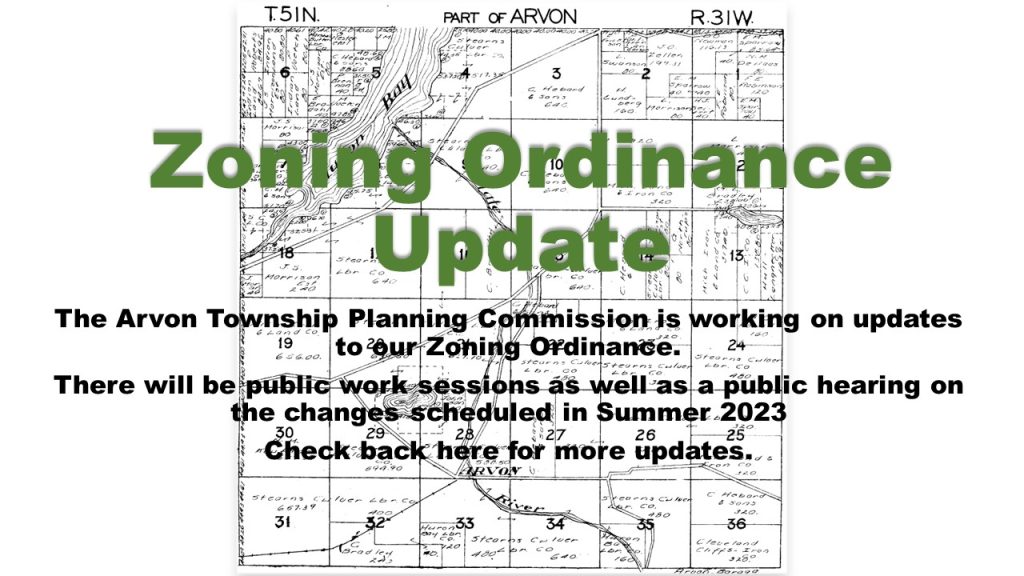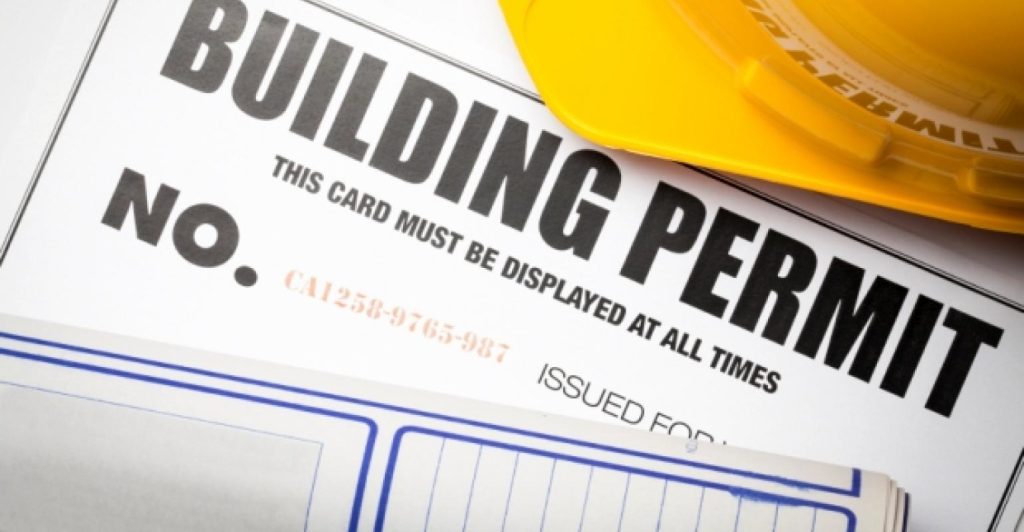Amendments to the Arvon Township Ordinance
For review in preparation for the Public Hearing on Thursday, August 18, 2022.
Article II – Definitions
Page 11/12
Delete “Accessory: Uses or structures both subordinate to a principal use or structure,” and subsection a. Building, subsection b. Accessory Housing Unit, and subsection c. Accessory Use.
Add new definitions:
Accessory building, structure, semi-tractor/trailer or portable storage container: A temporary or permanent building, structure, semi-truck, semi-trailer or portable storage container customarily incidental and subordinate to the principal building and located on the same lot as the principal building.
Accessory Use: A use which is clearly incidental to, customarily found in connection with, and (except in the case of some accessory off-street parking spaces or loading) located on the same lot as the principal use to which it is related. For example, a retail business is not considered customarily incidental to a residential use.
Page 19
After subsection J. of ECHO Housing add new definition.
Essential Services: The erection, construction, alteration or maintenance by public utilities or governmental units, boards or commissions of overhead or underground gas, electrical, steam or water distribution, transmission, collection, communication, or supply systems including mains, drains, sewers, pipes, conduits, wires, cables, fire alarm boxes, police call boxes, traffic signals, hydrants, water towers, poles, street lighting, electrical substations, gas regulator stations, utility pump and metering stations, and other similar equipment and accessories, but not including communication towers, which are reasonably necessary for the furnishing of adequate service by such public utility or public department or commission or for the public health, safety or general welfare is permitted in any zoning district. Notwithstanding the exceptions contained in the immediately preceding sentence
Page 25
Following definition of Porch, add new definition.
Portable Storage/Shipping Container: Temporary container used for transportation and storage. A setback of two hundred (200) feet right of way from road. No right of way on private road, keep structure away twenty (20) feet. This is to be applied in Farm Forest (FF) and Forest Resource (FR).
Page 27
Delete Recreational Unit. Insert new definition.
Recreational Unit: A vehicular type structure primarily designed as temporary living quarters for recreational, camping or travel use. It may have its own motive power, or it is mounted or drawn by another vehicle which is self-powered. (It is not a “mobile home”)
Add new definition after Roadside Stand.
Semi: A semi-truck or semi-trailer either as a separate or combined unit.
Page 28
Insert the following definition after Temporary Building or Use:
Tent: A temporary removable fabric or membrane shelter or enclosure for transient recreational activities.
Page 38
Article III – Zoning Districts and Maps
Section 3.2 Exemptions – revise section to read:
Exemptions: The location of pipes, wires, poles and generating transmission equipment of public utilities or railroad tracks regulated by the State of Michigan or by the United States are exempt as essential services in the ordinance.
Article IV – XII Zoning Districts – various pages.
Add the following paragraph to each listed zoning district: Section 500, page 45; Section 702, page 48; Section 902, page 51; Section 1102, page 53; Section 1202, page 57.
Required Conditions: “Small non-habitable structures such as utility buildings may be permitted within the minimum set back upon the approval of the Zoning Administrator.”
Page 47
Revise the following paragraph to Section 700 – Principal Use Permitted in R-R Zoning District, subparagraph to read:
Temporary mobile home or travel trailer. See Section 1511 for temporary uses.
Page 50
Revise Section 900 – Principal Uses Permitted Subsection 2 to read:
Temporary mobile home or travel trailer maintained in sound running condition with current vehicle license. A zoning permit is required obtained from the Zoning Administrator.
Page 50
Revise Section 901 – Principal Uses Permitted Subject to Special Conditions, subparagraph 4 to read:
Utility Grid Wind Energy System, an on-site use wind energy system over 20 meters (65.6 feet) high, and anemometer towers over 20 meters (65.6), and not to exceed three hundred thirty (330) feet, blade tip at its highest point.
Page 52
Section 1001 – Principal Uses Permitted Subject to Special Conditions, first paragraph, line 3:
Delete the words “Planning Commission” and replace with “Zoning Administrator”.
Section 1001 – Principal Uses Permitted Subject to Special Conditions, subparagraph 1, revise to read:
Resorts, resort hotels, vacation lodges, motor inns, motels, and other tourist lodging facilities, provided any use permitted herein shall meet Michigan Environmental Health Codes.
Section 1001 – Principal Uses Permitted Subject to Special Conditions, subparagraph 2, revise to read:
Travel trailer courts, tenting areas and general camping grounds when the site plan has been reviewed and approved by the Zoning Administrator provided that: a. The minimum State of Michigan health requirements governing travel trailer courts and camping areas for public use are complied with. Remove b, c, and d.
Page 68
Site Plan Review
Remove the word Addendum
Page 73
Article XIV – Uses Subject to Special Conditions
Section 1407 – Special Requirements. Subsection H – Other Uses of Mobile Homes and Trailers, subparagraph 4, line 2.
Delete the words “Planning Commission” and replace with “Zoning Administrator”.
Page 80
Article XV – General Provisions, Section 1500, Nonconformities, subparagraph 4 Nonconforming Use of Land and/or Structures, subparagraph a. to read:
Nonconforming use of land and/or structures shall not be enlarged or increased nor extended to occupy a greater area of land than was occupied at the effective date.
Page 91
Section 1502, Alternative Energy Sources, subsection 2 Solar Panels. Remove and replace with the following:
2. Solar Energy (10K or Less)
A. Purpose
It is the purpose of this section to promote the safe, effective, and efficient use of solar energy systems to generate electricity and heat. Further, it is the purpose of this section to standardize and streamline the review and permitting process for solar energy systems.
B. Findings
The Township has found that solar energy is an abundant, renewable, and nonpolluting energy resource of which some residents and utility companies would like to make use. Generation of electricity by these facilities will reduce dependence on non-renewable energy resources and decrease air and water pollution that results from the use of conventional fossil fuels. Solar energy systems will also enhance the reliability and power quality of the power grid, reduce peak power demands, and help diversify the Township’s energy supply.
C. Applicable township, state, utility and national codes, regulations, and standards.
All solar energy systems shall be designed, erected, and installed in accordance with applicable township, state, utility and national codes, regulations, and standards.
D. Definitions (apply only to this section)
Electricity Generation (aka production, output) – The amount of electric energy produced by transforming other forms of energy, commonly expressed in kilowatt-hours (kWh) or megawatt-hours (MWh).
Electrical Equipment: Any device associated with a solar energy system, such as an outdoor electrical unit/control box, that transfers the energy from the solar energy system to the intended on-site structure.
Grid-tied Solar Photovoltaic Systems (aka grid-tied PV, on-grid, grid-connected, utility-interactive, grid-intertied, or grid-direct): Solar photovoltaic electricity generation systems designed to serve the electricity needs of the building to which it is connected, thus offsetting a home’s or business’s electricity usage. Any excess electricity generated is sent to the electric utility grid, credited via a customer’s net metering agreement with their local utility. Grid-tied are typically installed without battery back-up system to store electricity. As such, these systems provide no power during an outage. Typical system components: PV panels, inverter(s), and required electrical safety gear.
Ground-Mount System: A solar energy system that is directly installed on specialized solar racking systems, which are attached to an anchor in the ground and wired to connect to an adjacent home or building. Ground-mount systems may be applicable when insufficient space, structural and shading issues, or other restrictions prohibit rooftop solar.
International Residential Code (IRC) – Part of the International Building code (IBC), the IRC sets buildings standards for residential structures.
Inverter: A device that converts the Direct Current (DC) electricity produced by a photovoltaic system is converted to useable alternating current (AC).
Kilowatt (kW) – Equal to 1000 Watts; a measure of the use of electrical power.
Kilowatt-hour (kWh) – A unit of energy equivalent to one kilowatt (1 kW) of power expended for 1 hour of time.
Mounting: The manner in which a solar PV system is affixed to the roof or ground (i.e. roof mount, ground mount, pole mount).
Megawatt (MW): Equal to 1000 Kilowatts; a measure of the use of electrical power.
Megawatt-hour (MWh)– A unit of energy equivalent to one Megawatt (1 MW) of power expended for 1 hour of time.
National Electric Code (NEC): Sets standards and best practices for wiring and electrical systems.
Pole-Mount Systems: A solar energy system that is directly installed on specialized solar racking systems, which are attached to pole, which is anchored and firmly affixed to a concrete foundation in the ground, and wired underground to an attachment point at the building’s meter. Unlike ground-mount systems, pole-mount systems are elevated from the ground. Pole-mounted systems can be designed to track the sun (with single-axis or dual-axis tracking motors) and maximize solar output throughout the year.
Power: The rate at which work is performed (the rate of producing, transferring, or using energy). Power is measured in Watts (W), kilowatts (kW), Megawatts (MW), etc.
Roof-Mount System (aka rooftop mounted, building mounted): A solar energy system consisting of solar panels are installed directly on the roof of a home, commercial building, and/or an accessory structure, such as a garage, pergola, and/or shed. Solar panels are mounted and secured using racking systems specifically designed to minimize the impact on the roof and prevent any leaks or structural damage. Roof-mount systems can be mounted flush with the roof or tilted toward the sun at an angle.
Solar Access: The ability to receive sunlight across real property to protect active or passive solar energy.
Solar Array: Multiple solar panels combined together to create one system.
Solar Collector: A solar PV cell, panel, or array, or solar thermal collector device, that relies upon solar radiation as an energy source for the generation electricity or transfer of stored heat.
Solar Energy System: A passive design using natural and architectural components to collect and store solar energy without using any external mechanical power or an active mechanical assembly that may include a solar collector, storage facility, and any other components needed to transform solar energy for thermal chemical, or electrical energy. Examples include a solar green house, solar panels, solar hot water heater, photovoltaic panels, passive solar panels, and a large, clear south-facing expanse of windows.
Solar Glare: The potential for solar panels to reflect sunlight, with an intensity sufficient to cause annoyance, discomfort, or loss in visual performance and visibility.
Solar Orientation: Orienting (positioning) a structure to take full advantage of optimal solar access and performance.
Solar-Ready: The concept of planning and building with the purpose of enabling future use of solar energy generation systems. Solar-ready buildings, lots, and developments make it easier and more cost-effective to utilize passive solar techniques and adopt active solar technologies in the future. Solar-Ready Buildings are built anticipating future installation of active solar energy systems (including structural reinforcement, pre-wiring or plumbing for solar, and east-west building orientation). Solar-Ready Lots are oriented to take maximal advantage of a location’s solar resource. Solar-Ready Developments expand this concept to entire subdivisions.
Watts (W): A measure of the use of electrical power (power (Watts) = voltage (volts) X current (Amps).
Wiring: Specified by electrical codes, solar PV system wires are routed from the panels or micro-inverters through conduit into the inverter and buildings meter.
E. Roof-Mounted and Wall-Mounted Solar Energy Systems
Roof-mounted and wall-mounted solar energy systems less than 10k for on-site use are permitted accessory structures in all zoning districts, subject to the following regulations:
- Height. Roof-mounted systems shall not extend more than three (3) feet above the surface of the roof. Wall-mounted systems shall not exceed the height of the wall.
- Location. Wall-mounted solar energy systems may be located anywhere on a roof of a principal or accessory structure, but shall not be located in a required setback nor protrude beyond the edge of the roof. However, a solar panel may function as a roof element, such as an awning or carport. Wall-mounted solar energy systems may be located anywhere on the wall of a principal or accessory structure, but shall not be located within a required setback area.
F. Ground-Mounted Solar Energy Systems (10 kW or less).
Ground mounted and freestanding solar energy systems of 10kW or less for on-site use are permitted accessory structures in all zoning districts, subject to the following regulations.
- Location and Setbacks. Ground-mounted solar energy systems shall be located to the side or rear of the principal building. Solar energy systems shall be located at least three (3) feet from a side lot line and at least five (5) feet from a rear lot line.
- Area. Ground-mounted solar energy systems are not classified as lot coverage and are therefore, not subject to the maximum lot coverage standards of the zoning district.
- Power Lines. All power lines between solar panels and inverters must be placed underground.
G. General Standards
The following requirements are applicable to all roof-mounted, wall-mounted, or ground-mounted solar energy systems.
- Permit. A zoning compliance permit shall be required for any roof-mounted, wall-mounted, or ground-mounted solar energy system. A building permit may be required for these facilities.
- Batteries. If solar storage batteries are included as part of the solar collector system, they must be placed installed according to all requirements set forth in the National Electric Code and State Fire Code when in operation. When no longer in operation, the batteries shall be disposed of in accordance with the laws and regulations of the Township and any other applicable laws and regulations relating to hazardous waste disposal.
- Electrical Emissions. The design and construction of solar energy systems shall not produce electrical emissions that would interfere with aircraft communications systems or navigation equipment.
- Light Emissions and Reflection. The design and construction of solar energy systems shall not produce light emissions, either direct or indirect (reflective), that would interfere with pilot vision and/or air traffic control operations. The solar panels shall be composed of anti-reflective material and/or treated with anti-reflective coating.
- Removal. If a solar energy system ceases to perform its intended function (generating electricity) for more than twelve (12) consecutive months, the operator shall remove the collectors, mounts, and associated equipment and facilities no later than ninety (90) days after the end of the twelve (12) month period.
- Utility Connection. The applicant shall submit evidence that the utility company has been informed of the customer’s intent to install an interconnected, customer-owned solar energy generator and that such connection has been approved. Off-grid systems shall be exempt from this requirement.
Page 101
Section 1511 – Temporary Uses, Paragraph A, subparagraph 1
After the last word “maximum” in the paragraph add: “or upon the discretion of the Zoning Administrator”.
Page 101-102
Section 1511 – Temporary Uses.
In the last paragraph under subparagraph 2, line 2, after the words “use”, delete the words “is not connected to any utility service”.
Page 102
Section 1511 – Temporary Uses. Paragraph A, after subparagraph 5, add the following:
6. Semis are allowed as temporary accessory structures only in Zoning Districts B-1 and I-1. Temporary zoning permit is required that is valid for ninety (90) days and may be extended up to an additional ninety (90) days at the discretion of the Zoning Administrator. Does not apply to the parking of semis temporarily at the residence of the semi-driver for less than seven (7) days.
7. Portable storage shipping containers are allowed as temporary accessory structures iin any district. A temporary zoning permit is required that is valid for ninety (90) days and may be extended up to an additional ninety (90) days at the discretion of the Zoning Administrator.
Page 118
Article XVII – Administration
Section 1700 – General Administration
In line 2, delete the words “Planning Commission”, and replace with the words “Township Board”.






